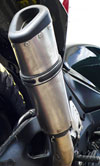Exhausts: Feeling the Heat (2)
 Last month we looked at the problem of how to contain excessive heat given off by hot exhausts. The problems this heat causes affect not only the engine, but also other systems, particularly electronics. In addition to wrapping or coating the exhausts, we looked at the concept of bagging or blanketing. Heat shields were mentioned and in Formula One at least these are commonplace, being lightweight and effective in shielding the engine from radiative heat transfer. The problem with wrapping or bagging of exhausts is the additional weight which would affect the reliability of the exhaust system for Formula One, where the entire system mass is constrained only at the joint face on the cylinder head. With the exhaust cantilevered from the engine, the system would have to be made sturdier to cope with the additional stress.
Last month we looked at the problem of how to contain excessive heat given off by hot exhausts. The problems this heat causes affect not only the engine, but also other systems, particularly electronics. In addition to wrapping or coating the exhausts, we looked at the concept of bagging or blanketing. Heat shields were mentioned and in Formula One at least these are commonplace, being lightweight and effective in shielding the engine from radiative heat transfer. The problem with wrapping or bagging of exhausts is the additional weight which would affect the reliability of the exhaust system for Formula One, where the entire system mass is constrained only at the joint face on the cylinder head. With the exhaust cantilevered from the engine, the system would have to be made sturdier to cope with the additional stress.
There is another reason why it might not be desirable to insulate the exhaust system. If we retain more heat within the exhaust, we must therefore have a higher gas temperature at any point along the length of the exhaust system. The speed of sound in any gas increases with temperature, and it is for this reason that insulation has a direct effect on the design of the exhaust system. If we retain more heat in the exhaust, the time taken for a pressure wave to reach a point of reflection (an open end, or a sudden expansion or contraction are examples) is reduced, and consequently the time taken for the reflected wave to return to the engine is affected in a similar manner.
If we take a very simple example of having a uniform exhaust temperature of 723 degrees C (this is 1000 K in absolute temperature) for an uninsulated exhaust, and this is then increased to 1200K by means of thermal insulation, we would find that the increase in the speed of sound of the exhaust gas increases by the ratio of the square root of the absolute temperatures, i.e. for the 10% increase in gas temperature, we would see a 4.9% increase in sonic speed. In theory, if we wish to maintain the same exhaust tuning behaviour, the exhaust would need to be 4.9% longer. So, in addition to the extra mass of the coating, bagging or wrapping, we might need to increase the length and therefore mass of the exhaust system by at least 4.9% as in this example. Many people would not go so far as to re-optimise the exhaust tuning behaviour when insulating the exhaust, but in critical applications where the exhaust has been optimised and the decision has been taken to insulate, this re-optimisation might be seen as a necessary step. Not only does this involve additional mass, but also time, design and testing resource at no little expense.
Noting the above, you should therefore consider carefully the options for exhaust system insulation before committing to any choice. As ever, there are compromises to be struck here, and in solving one problem, we may inadvertently create another, especially if the exhaust system has been carefully optimised beforehand.
Written by Wayne Ward.